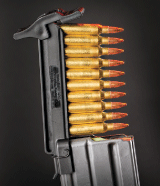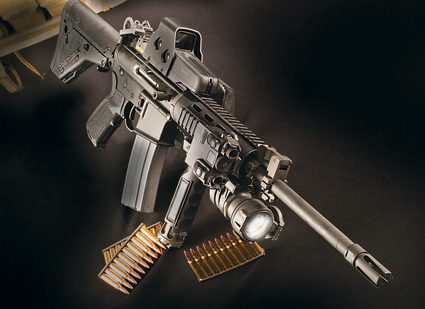These days M4-type carbines are hot for law enforcement and civilian self-defense. They are light, handy, compact and offer a greater level of performance than any pistol caliber carbine. For this reason, many law enforcement agencies are changing over from pistol caliber sub-machine guns (SMG) for SWAT use to M4A1-type carbines. Ammunition and parts are plentiful and reasonably priced. In fact, one of the greatest strengths of the M4A1-type carbine is its modular capability.
 It wasn’t originally intended to be a modular weapon, but it became one in the early 1990s when the Special Operations Command (USSOCOM) developed the SOPMOD (Special Operations Peculiar Modification). In the department where I serve as a reserve officer, for example, every full-time officer is issued a semi-automatic M4A1-type semi-auto carbine for patrol carry. Several full-time and reserve officers have purchased carbines of their own for personel and duty use.
It wasn’t originally intended to be a modular weapon, but it became one in the early 1990s when the Special Operations Command (USSOCOM) developed the SOPMOD (Special Operations Peculiar Modification). In the department where I serve as a reserve officer, for example, every full-time officer is issued a semi-automatic M4A1-type semi-auto carbine for patrol carry. Several full-time and reserve officers have purchased carbines of their own for personel and duty use.
Gun Details
That said, most M4-type carbines are bare bones affairs that require the addition of aftermarket stocks, rail handguards, pistol grips and more. Not so with the Fulton Armory Universal Precision Rifle (UPR). Fulton Armory has an outstanding reputation for building rifles of the highest quality, whether the classic M1 Garand, M14-type or AR in either .223 or .308 caliber.
Advertisement — Continue Reading Below
Fulton Armory ARs are built from aircraft aluminum forgings. Upper receivers are made of 6066T6 and lowers from 6061T6 aluminum, hard coat anodized and Teflon-coated. Fulton Armory ARs are true custom rifles, each rifle essentially “built to print” with tolerances as close as possible to military specification, although Fulton Armory ARs are fully compatible with Mil-Spec .223 ARs from other manufacturers.
What makes the UPR any different from any other AR? First and foremost, Fulton Armory uses only the best components available, beginning with stripped receivers from US military contractors. The UPR is available as a rifle with a 20-inch barrel or like our test carbine with 16.5-inch tube. Barrels are Krieger’s Criterion with four-groove, 1-in-9-inch twist rate rifling with chrome lining optional. Barrels are available in plain stainless or target gray. This matte finish reduces glint under tactical conditions and at the same time provides a finish that is esthetically pleasing and durable.
The muzzle end of the UPR barrel is fitted with a Smith Enterprises Vortex flash suppressor as standard. The gas block is by Yankee Hill and incorporates a folding front sight. The fit and finish of the UPR is among the very best we have ever encountered in an AR. The finish of upper and lower receivers is a perfect match and there is no “slop” whatsoever between the upper and lower.
Advertisement — Continue Reading Below
The UPR is intended for use as a precision tactical or perimeter rifle and with this mission in mind we set about equipping our UPR for testing. Every UPR is guaranteed to deliver sub-minute-of-angle (MOA) accuracy out of the box.
Our test UPR came equipped with the Yankee Hill accessory free-floating tube that not only free floats the barrel along its entire length, but it also adds a full-length top and bottom rails for optics and night vision equipment, along with shorter side rails for other accessories. The Fulton Armory UPR lower is also the best of its kind. The standard two-stage trigger breaks at exactly 3.5 pounds. The other UPR lower receiver components are also high quality. The pistol grip is a Magpul unit contoured for much better grip than standard AR-type grips with replaceable backstrap and waterproof storage compartment for batteries and other small items.
Our test UPR came with a Magpul adjustable buttstock. Not only is the stock completely adjustable fore and aft for use with body armor, equipment or between individuals of different sizes, the cheek rest is adjustable for both up and down, and fore and aft movement. The rubber buttpad is also adjustable up and down for shooters of any size. We were able to obtain a perfect cheek weld by adjusting the cheekpiece and buttpad a bit in both directions. The UPR manual lists a Command Arms stock as an option, but we found the Magpul unit to be perfectly satisfactory.
Advertisement — Continue Reading Below
What really sets the UPR apart is its upper “slickside” receiver with the side-charging handle that eliminates the forward assist, dust cover and case deflector. The side-charging handle is a tremendous upgrade and we have to wonder why someone hadn’t thought of this before. The top-charging handle was always considered a disadvantage for a number of reasons.
First, if one wanted to press the bolt forward to ensure that a round was chambered, there was no way to do it until the Army insisted on a forward assist when the M16A1 was adopted in the late 1960s. When flattop receivers and optics began to enter widespread use, things got worse because the optics interfered with the charging handle. Moreover, just pulling the charging handle necessitates taking the rifle down from the shooter’s shoulder.
The side-charging handle eliminates all these issues and acts as case deflector, to boot. What’s the downside? A bolt that must be removed to disassemble the rifle for cleaning retains the charging handle or maintenance using a 3/16 Allen wrench. Otherwise the UPR comes apart just like any other AR.
Advertisement — Continue Reading Below
EOTech HWS
The UPR was obviously designed for optics as the primary sighting system. The EOTech Holographic weapon sight (HWS) projects a laser holograph onto a vertical piece of hardened glass. Even with the glass broken, the 65-MOA circle and four aiming dots are visible. The reticle provides four aiming dots for target distances of 0 to 300 meters, 400 meters, 500 meters, and 600 meters, respectively when used with the optional EOTech 3x magnifier. In fact, some special operations EOTech users do not even employ the reticle at CQB (close quarter battle) distances of about 25 meters or less. They simply frame the target in the sight’s aircraft aluminum housing and shoot it.
Our EOTech was the latest M557 military version that mounts via a cantelivered base with a knurled bolt. This latest EOTech is powered by two AA batteries. The M557 EOTech also features a battery compartment tether so it can’t be dropped and lost. EOTechs can be dismounted and remounted with no more than 1-MOA change in zero.
RELATED: Why the EOTech 512 Holographic Weapon Sight Became So Popular
Advertisement — Continue Reading Below
OSTI NVS
Today’s tactical operations are a 24/7 affair and most tactical units equip their carbines with night vision optics. A significant development in night vision technology is Optical System Technology’s Gen III+ family of NVS (night vision sight) that includes the current military standard AN/PVS-22 Universal Night Sight (UNS) and the AN/PVS-27 Magnum Night Sight (MUNS). Images seen through the AN/PVS-22 in almost total darkness are amazingly clear with nothing to distract the shooter. Since the AN/PVS-22 mounts ahead of the day optic on a MIL-STD-1913 rail, eye relief is not an issue.
Although the EOTech M557 used on our UPR has IR (infrared) modes, they aren’t necessary if the optic is used in conjunction with the AN/PVS-22 or other OSTI NVS. The AN/PVS-22 mounts via a LaRue Tactical QD throw lever that locks into place and is adjustable for wear and tension. The AN/PVS-22 has no affect on the day optic’s reticle or the rifle’s zero and, of course, can be used as a stand alone NVS.
All OSTI NVS are autogated with a sensor that senses bright light or muzzle flashes and automatically regulates the amount of light reaching the intensifier tube. All OSTI NVS are also shock mitigated, meaning that they can be used on weapons having heavy recoil such as .50BMG caliber bolt-action rifles.
Advertisement — Continue Reading Below
SureFire M900 WeaponLight
He also added a SureFire M900 Vertical Foregrip WeaponLight with an IR filter to or test UPR. This foregrip/high intensity light has ambidextrous momentary activation pads for the main white light, a constant on switch and a momentary push switch for the two integral low output LEDs that are used for stealth navigation. The white light emits 125 lumens of high intensity focused light for an hour and attaches to the bottom MIL-STD-1913 rail via a LaRue Tactical QD throw lever. The M900 completes the night operations suite that we fitted to our UPR. The combination of the M900 and AN/PVS-22 gives any soldier or police officer an advantage over their adversaries.
For situations like in complete darkness, the SureFire M900 accepts an IR filter that fits over the lamp lens, enabling the carbine user to clear using an IR light that is invisible to the human eye. For today’s military and law enforcement, 24/7 means just that and every military individual or police officer, especially SWAT personnel, should put quality night vision devices near the top of their acquisition list if they haven’t already done so.
Tactical Mirror Sight
Finally, we added a Tactical Mirror Sight (TMS) that not only acts as a back-up iron sight but also enables the user to actually shoot around corners or clear rooms without fully exposing himself or herself to threats. To use the TMS, it is simply raised to the upright position and rotated 45 degrees so the user can extend the carbine laterally across his or her body and look through the optic through the mirror from behind cover.
Advertisement — Continue Reading Below
Click detents ensure that the mirror is in the correct position for either right- or left-handed use. The design is such that the user’s hands are also behind cover. All that is exposed is the carbine. When not in use and folded down, the TMS does not interfere in any way with the day optic.
Bringing the TMS head up to the first detent raises a standard AR aperture rear sight into position for aiming through the EOTech or other optic. The sighting mirror is chemically hardened glass. A larger clip-on mirror for room clearing just slides into place over the sighting mirror and is made of virtually unbreakable polycarbonate.
Final Notes
Shooting the UPR was just like every Fulton Armory rifle we have tested – the rifle ran with total reliability and excellent accuracy. Fulton Armory has built a custom rifle with the best components available at a reasonable price. If our test carbine was any indication, Fulton Armory has hit a homerun with its new FAR-15 UPR.
Advertisement — Continue Reading Below























